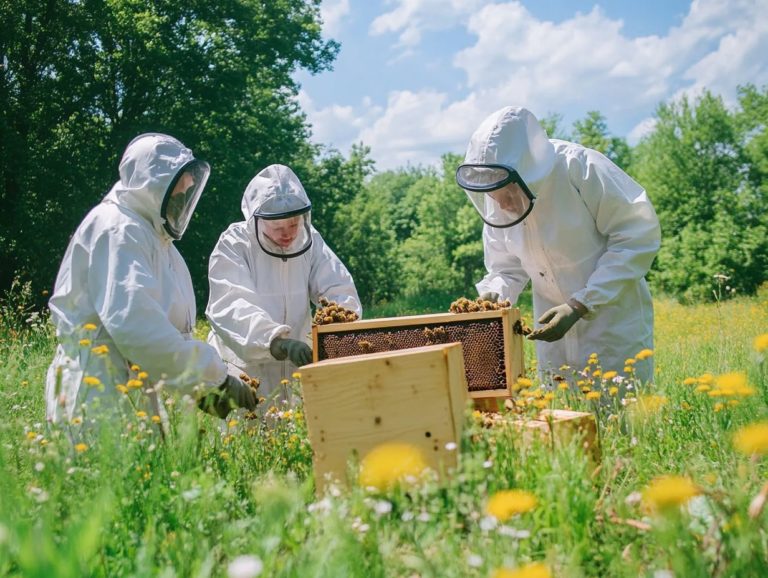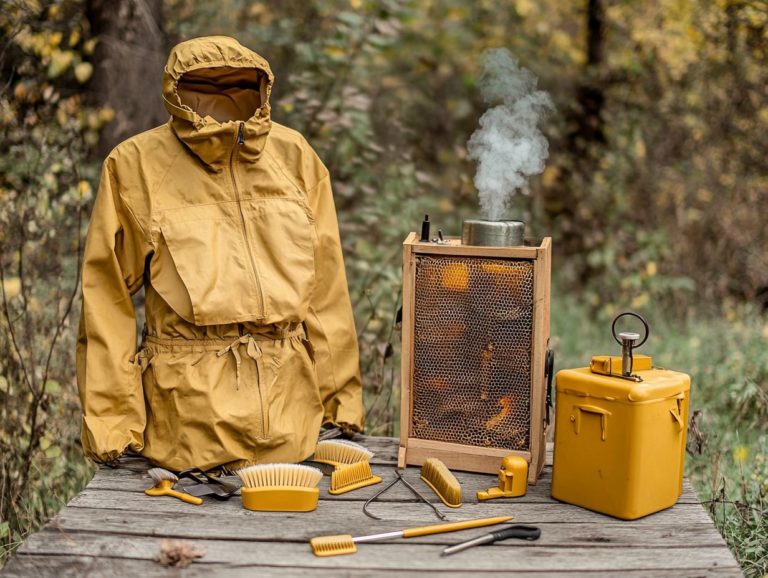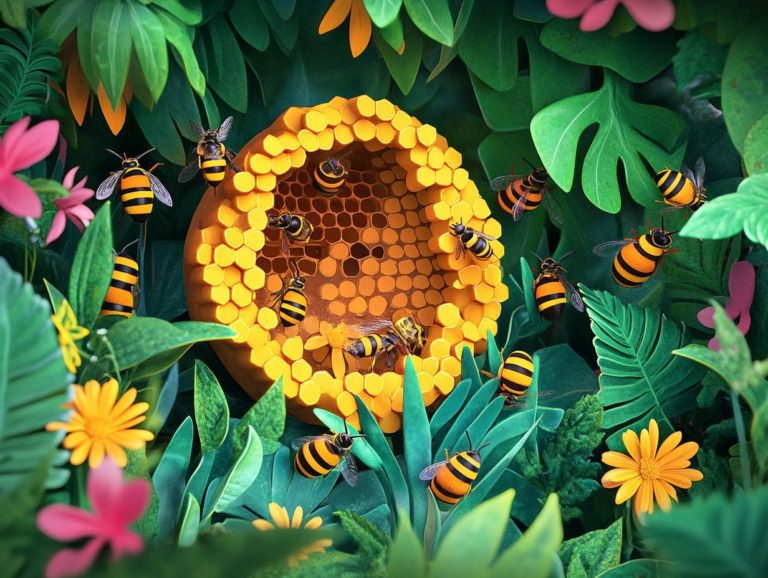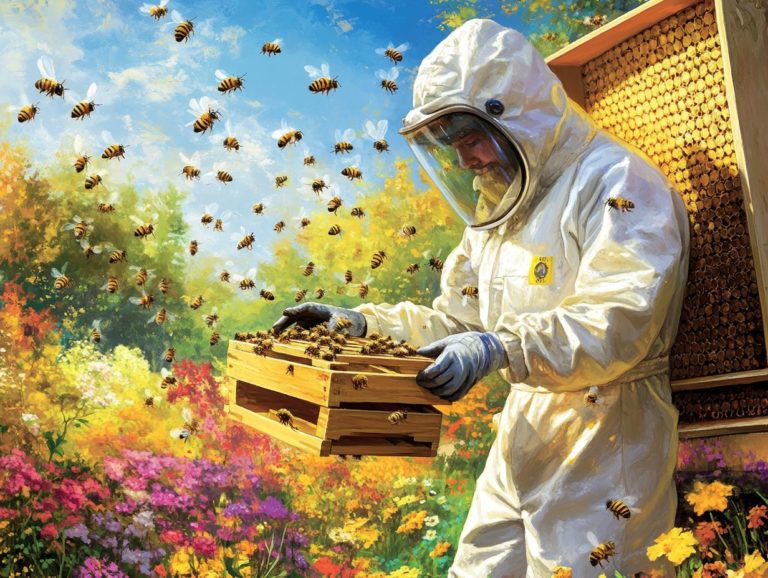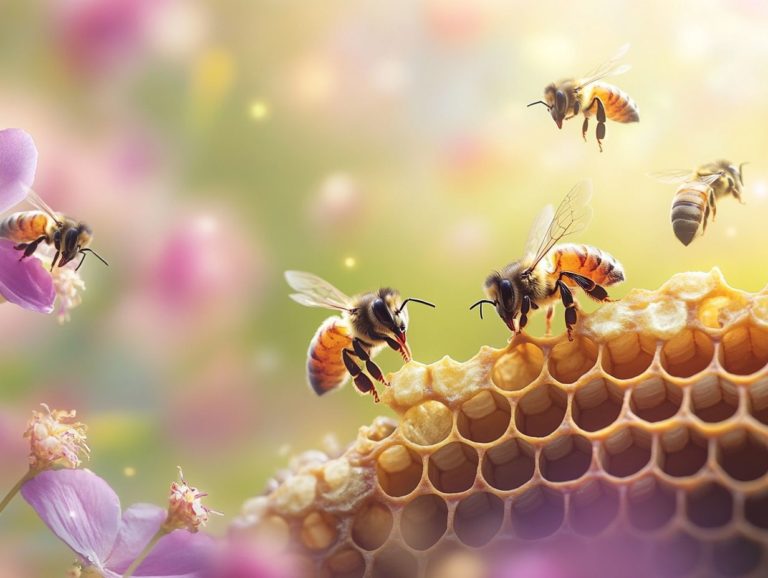Best Hive Management Practices for Beginners
Beekeeping is not just a hobby; it s a rewarding and fascinating endeavor that nurtures local ecosystems while offering you the delightful bounty of honey. It also supports crucial processes like almond pollination and agricultural crops production.
As a beginner, the journey ahead may feel overwhelming, but don t worry! With the right knowledge and management techniques, you can thrive as a beekeeper.
This article presents essential hive management practices designed to set you on the right course, from selecting the ideal location for your hive to mastering pest control, supplemental feeding, and proper harvesting techniques.
Whether you re simply curious or fully prepared to dive into the world of beekeeping, this guide will provide you with the tools necessary for a flourishing beekeeping experience. Understanding the role of genetic diversity and maintaining good contract agreements with commercial beekeepers can enhance your journey.
Contents
- Key Takeaways:
- 1. Educate Yourself on Beekeeping Basics
- 2. Choose the Right Location for Your Hive
- 3. Invest in Quality Equipment
- 4. Start with a Small Number of Hives
- 5. Regularly Inspect Your Hive
- 6. Monitor and Control Pests and Diseases
- 7. Provide Adequate Food and Water for Your Bees
- 8. Practice Proper Harvesting Techniques
- 9. Stay Up-to-Date on Beekeeping Regulations
- 10. Join a Local Beekeeping Association
- How to Prepare for Your First Hive Inspection?
- Frequently Asked Questions
- What are the best hive management practices for beginners?
- How often should I inspect my hive as a beginner?
- What should I look for during hive inspections in Missouri?
- How can I manage pests and diseases in my hive?
- What is the best way to feed my hive as a beginner in California?
- How can I ensure my hive is prepared for winter as a beginner in regions like California and Missouri?
Key Takeaways:
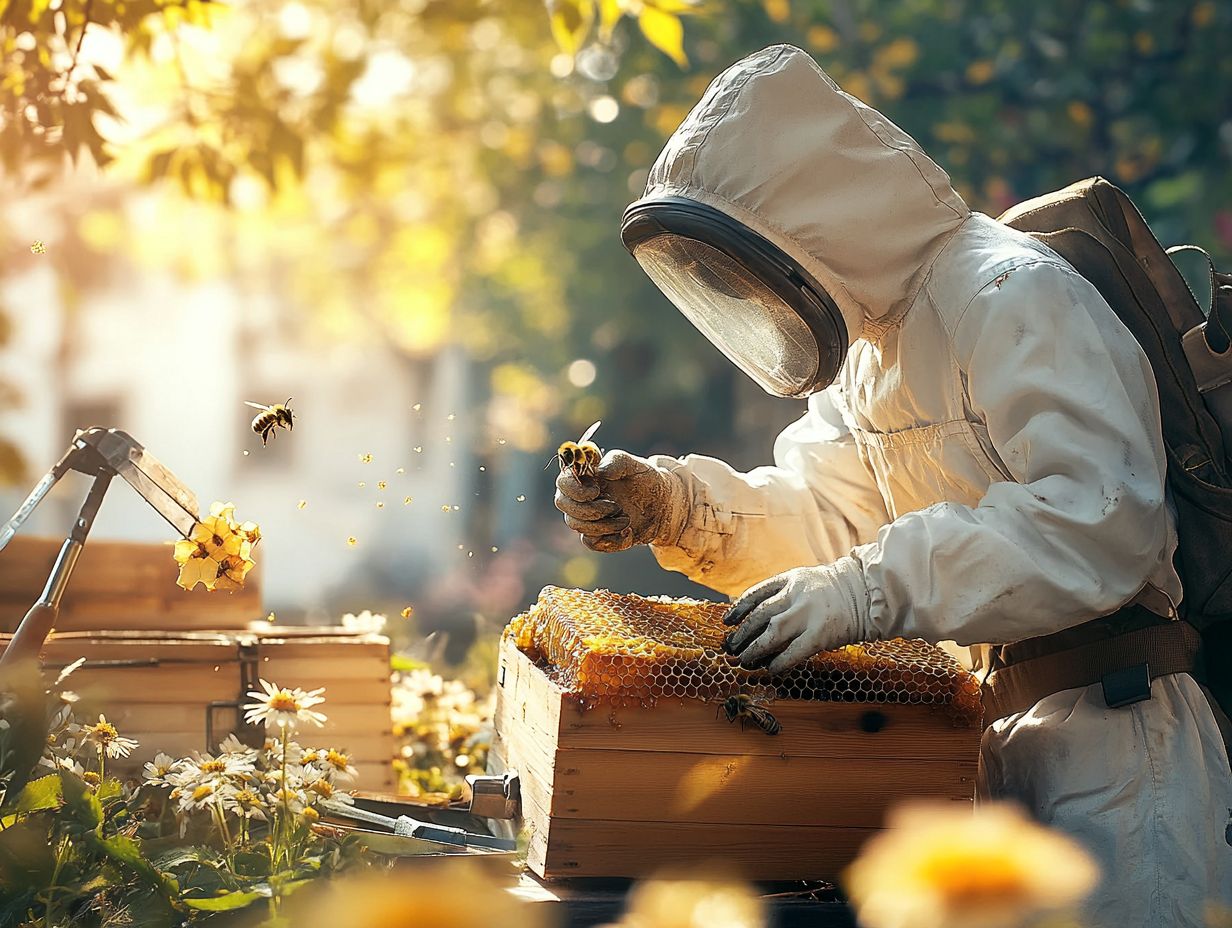
- Educate yourself on beekeeping basics, including safety protocols, before starting your hive journey.
- Choose a suitable Apiary location for your hive to ensure the health and productivity of your bees.
- Invest in quality equipment to provide a safe and efficient environment for your bees, including protective gear.
1. Educate Yourself on Beekeeping Basics
Understanding the foundational aspects of beekeeping is crucial for any aspiring beekeeper. It involves gaining knowledge about honey bees, their biology, and behavior. Implementing best practices keeps your hives healthy and productive.
This journey of education means grasping the lifecycle of bees and the importance of genetics. You must also recognize potential threats, such as diseases like Nosema ceranae and Varroa mites, which can lead to Colony Collapse Disorder if not managed effectively. The Honey Bee Health Coalition provides valuable resources for dealing with these threats.
As a beginner, you should prioritize learning about hive maintenance, ensuring you know how to properly set up and care for your colonies. Monitoring bee health, particularly the Queen’s health, is another vital aspect that will equip you with the skills to identify early signs of distress or disease.
Don t miss out on resources like the American Bee Journal and Bee Culture. They offer crucial insights and updates that will lay a solid foundation for your beekeeping journey!
It s also essential for you to comprehend the various pests and the diseases they can carry, as understanding these factors is essential for sustaining a thriving beekeeping practice in the long run. Joining local beekeeper associations can also provide support and shared knowledge.
2. Choose the Right Location for Your Hive
Selecting the ideal Apiary location is a crucial step in your journey toward successful beekeeping. The site you choose should offer abundant water sources, access to diverse floral resources for pollination, and a safe environment that minimizes stress on your honey bees, ultimately ensuring their productivity. Consider the proximity to water sources to aid in digestion and temperature regulation.
You ll find that factors like proximity to agricultural crops can significantly boost honey production, as bees flourish in areas teeming with blooming plants. For example, regions such as California and Missouri have long been the go-to spots for commercial beekeepers, thanks to their expansive agricultural landscapes and favorable climates.
It s equally important to ensure that these locations are free from harmful pesticides and pollutants, which can put the health of your colonies at risk. Malnutrition should also be avoided by ensuring a variety of nutritional sources are available.
By carefully considering these factors, you can create a nurturing environment that supports bee populations and leads to a bountiful honey harvest.
Get excited about this rewarding journey! Your beekeeping adventure awaits, and with each step, you ll create a positive impact on the environment while enjoying the sweet rewards of honey.
3. Invest in Quality Equipment
Investing in high-quality beekeeping equipment is essential for maintaining your hives and ensuring the health of your honey bees. The right tools enhance management skills and help prevent diseases and pests.
To foster a thriving apiary, prioritize durable hives that can withstand various weather conditions. Don t forget protective gear gloves, veils, and suits are crucial for keeping you safe during hive inspections.
Having essential tools like smokers, hive tools, and bee feeders is equally important. These allow you to monitor your colony s health and provide food when natural sources are scarce. Use pest management techniques like traps and natural treatments to protect your bees and support a successful beekeeping experience.
4. Start with a Small Number of Hives
If you re a beginner beekeeper, starting with a small number of hives is a smart way to manage hive maintenance and monitor bee health carefully. This enables you to develop essential skills without feeling overwhelmed.
This method sharpens your hive management techniques and lays the groundwork for understanding bee behavior and health indicators. By focusing on just a few hives, you can easily observe patterns, learn what works, and make necessary adjustments. Consulting with university research programs, like those at the University of Missouri, can provide valuable guidance.
This focused strategy is a fantastic chance to assess the genetic quality of your bee colonies. You ll be empowered to select stronger stocks for future growth.
As time goes on, refine your management practices based on firsthand experience and the unique needs of your bees. This will ultimately foster a more sustainable and rewarding beekeeping journey.
5. Regularly Inspect Your Hive
Regularly inspecting your hive is essential for monitoring bee health, spotting issues like Varroa mites, and ensuring your Queen is thriving vital for your colony s productivity.
During inspections, assess key indicators of hive vitality. Pay close attention to the Queen’s behavior; she should lay eggs consistently, and the brood patterns should be healthy and uniform. Watch for any signs of disease, such as discolored or damaged brood, and unusual behavior from the bees, which could indicate stress or infection. Consulting with experienced apiary inspectors can help you improve your inspection skills.
Monitoring for pests is equally important. Act quickly! Early detection of intruders like moths or beetles is vital to protect your colony. Embracing regular inspections as a proactive approach fosters healthier hives, boosts honey production, and sets the stage for successful beekeeping endeavors. Regular communication with other beekeepers can provide insights into common local pests and diseases.
6. Monitor and Control Pests and Diseases
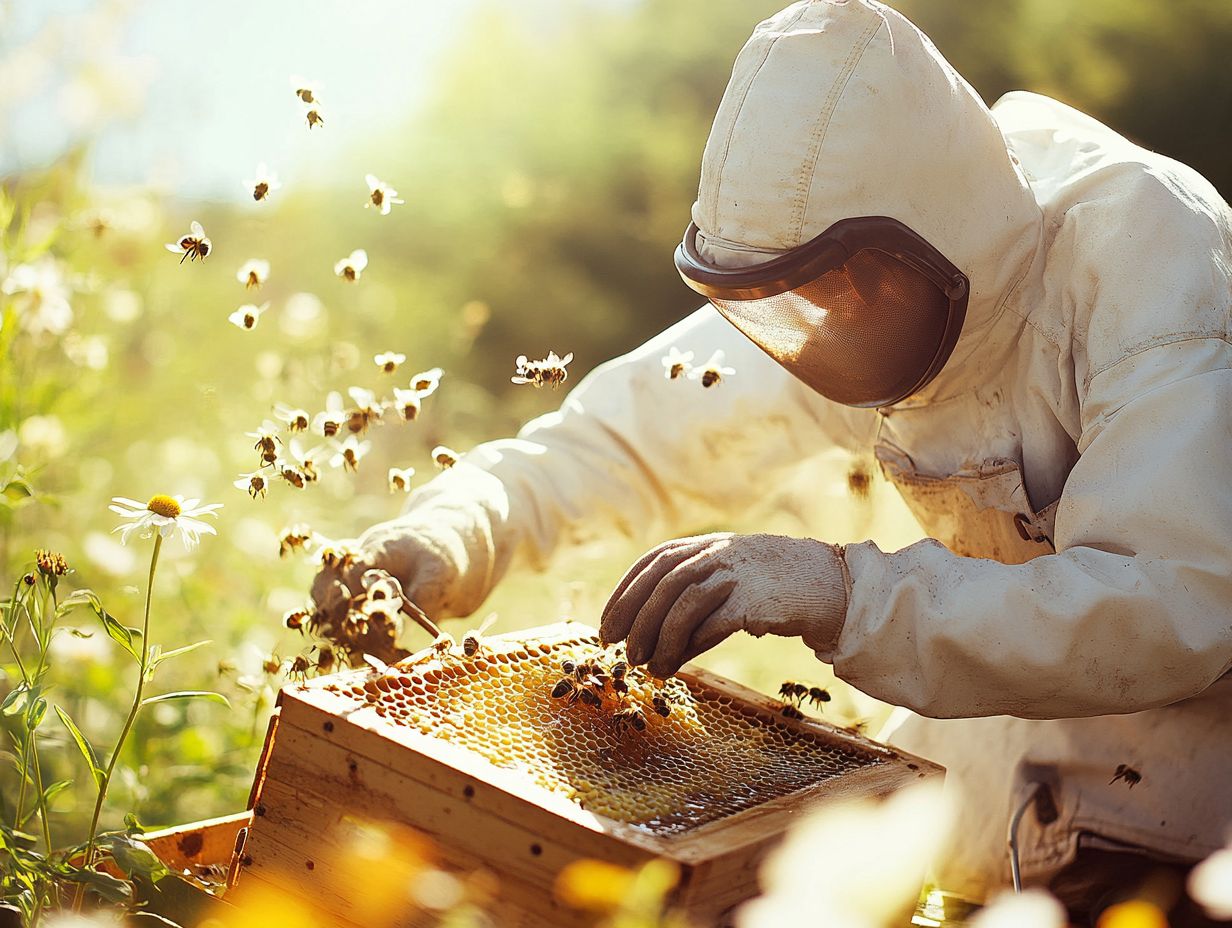
Effectively monitoring and controlling pests and diseases is essential for maintaining a healthy bee population.
Issues like Varroa mites and fungal diseases can wreak havoc on colonies if not managed properly.
Beyond Varroa mites, which latch onto bees and drain their vitality, you must remain vigilant about other common threats like Nosema.
Nosema is a fungal infection that can cause serious digestive issues in your bees. Watch for signs such as a sudden drop in bee numbers, unusual behaviors, or the disturbing presence of dead bees in and around the hive.
Regularly consulting with entomologists can help you stay ahead of emerging threats.
You can use various methods to manage pests effectively, including:
- Regular hive inspections
- Utilizing resistant bee strains
- Applying targeted treatments
Continuously educating yourself on evolving methodologies and treatment protocols not only enhances your skill set but also prepares you for emerging challenges, ultimately safeguarding these vital pollinators and supporting the health of the ecosystem.
Engaging with the Honey Bee Health Coalition can provide you with cutting-edge insights and strategies.
7. Provide Adequate Food and Water for Your Bees
Providing your bees with adequate food and water sources is crucial for their nutrition and overall colony health.
Malnutrition can weaken hives and make them more susceptible to diseases. Water sources should be clear and accessible to aid in digestion and temperature regulation.
To truly thrive, honey bees need a well-rounded diet that includes carbohydrates from nectar and protein from pollen, along with essential fats and vitamins from a variety of floral sources.
During critical periods, like early spring when foraging options are limited or late fall when resources begin to dwindle, supplemental feeding is especially important.
You should ensure your colonies have access to high-quality sugar syrup or protein patties to help sustain their energy levels.
Furthermore, maintaining reliable water sources near the hive plays a significant role in digestion and temperature regulation, both of which are vital for fostering healthy, productive colonies.
This holistic approach to bee care is essential for cultivating robust and resilient hives. Monitoring their nutritional intake and supplementing when necessary ensures their strength and resilience.
8. Practice Proper Harvesting Techniques
Mastering proper harvesting techniques will boost your honey yield and keep your hives thriving!
Employing improper methods can lead to unnecessary stress or damage to your bees. Always follow safety protocols during the harvesting process.
For a bountiful harvest, plan your collection carefully for late summer or early fall when the honey stores are abundant, allowing you to safely remove the excess.
Essential equipment for your harvesting endeavor includes:
- A bee suit to ensure personal safety
- Gloves
- A smoker to keep the bees calm
- Uncapping tools
- An extractor for collecting honey
Approach the hive with a calm demeanor to minimize disturbance, ensuring that the bees remain as undisturbed as possible.
Following best management practices involves checking the health of the hive beforehand and adhering to safety protocols. Having a first-aid kit on hand is crucial, so both you and your bees stay protected throughout the process.
Be aware that Varroa mites can significantly affect hive health.
9. Stay Up-to-Date on Beekeeping Regulations
Staying informed about beekeeping regulations is essential for you as a beekeeper. Adhering to local laws and safety protocols can profoundly impact the health of your hives and your relationship with the surrounding community.
Understanding these regulations is not just about ticking boxes; it cultivates a responsible beekeeping culture that protects both the bees and the environment. Local guidelines often specify how to register your hives, report bee diseases, and manage hive populations effectively to prevent the spread of germs that can harm the bees like Nosema ceranae.
The importance of proper hive management practices cannot be overstated. They play a pivotal role in ensuring the sustainability of beekeeping in your area. Utilize resources like beekeeper associations and esteemed publications such as the American Bee Journal and Bee Culture. For those starting out, hive management for beginners will keep you updated on vital regulations and best practices, offering continuous education and support for both novice and seasoned beekeepers.
10. Join a Local Beekeeping Association
Joining a local beekeeping association opens the door to invaluable support and a wealth of educational resources. This creates a vibrant community among fellow beekeepers, enhancing your overall beekeeping journey through shared knowledge and networking opportunities. For instance, associations in California and Missouri offer region-specific advice that can be particularly useful.
By participating actively in these associations, you gain access to a variety of workshops that explore essential beekeeping techniques and the latest regulations. This environment of continuous learning sharpens your hive management practices and connects you with experienced mentors eager to share their insights and strategies.
Being part of this community keeps you informed about the latest advancements and challenges in the field. It fosters personal growth and builds your confidence in effectively managing hives. These relationships create a nurturing atmosphere for both the bees and beekeepers alike, reinforcing a collective commitment to sustainability.
How to Prepare for Your First Hive Inspection?
Preparing for your first hive inspection requires thorough planning and a solid grasp of best practices to ensure both your safety and the well-being of your bees. An effective inspection can reveal crucial insights into the health of your colony, including Queen health.
Before diving into the hive, gather the right tools:
- Hive tool
- Smoker
- Protective gear
- Bee brush
Familiarizing yourself with the signs of a healthy hive like active foraging and robust brood patterns is vital for distinguishing between thriving colonies and those that might be struggling or facing diseases.
Implementing safety protocols, such as donning appropriate gear and using a smoker to calm the bees, minimizes stress on the hive. Taking these steps sets you and your bees up for success during the inspection. This careful approach creates a productive environment for both you and your bees, setting the stage for a successful journey into the world of beekeeping.
What Are the Common Mistakes Made by Beginner Beekeepers?
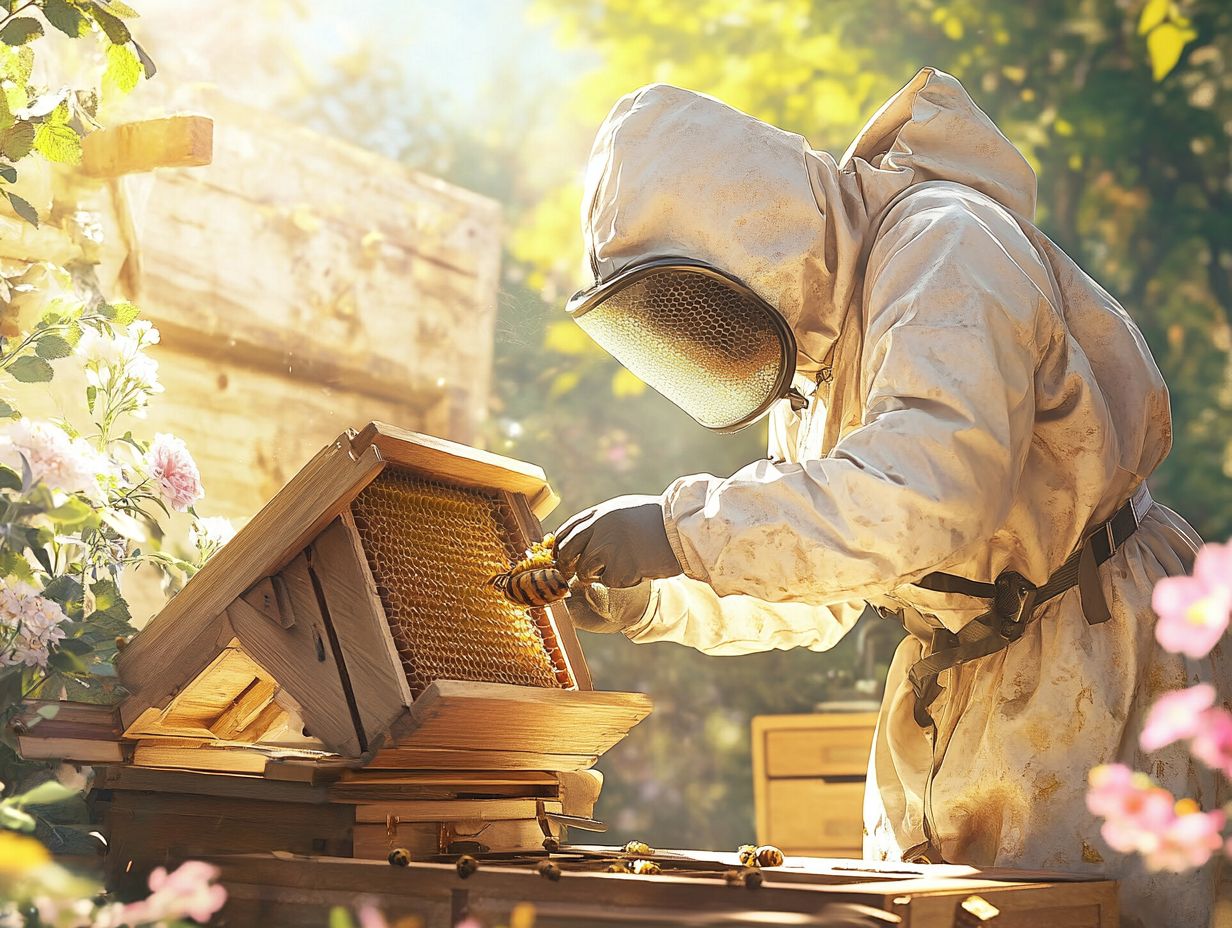
As a beginner beekeeper, it’s easy to fall into common traps that can undermine your hive maintenance. Overlooking signs of distress or neglecting best management practices can lead to significant issues, from weak colonies to low honey production.
Additionally, not paying attention to bee nutrition can have detrimental effects on your hive. One common misstep is inadequate hive inspections; when you fail to regularly monitor your bees’ behavior and health, you’re setting yourself up for trouble.
Improper feeding techniques can leave your colony lacking the necessary supplies needed for survival, especially during those harsh seasons. Pest control is another critical area where negligence can have dire consequences; pests like mites can wreak havoc on your hive if not managed effectively.
To avoid these pitfalls, you must commit to ongoing education to keep your bees thriving! Attend workshops and remain flexible to the evolving needs of your hives. Embracing continuous learning and taking a proactive stance will help ensure the health and productivity of your colony thrive.
Organizations like the Honey Bee Health Coalition offer resources to help you stay informed.
How Can You Prevent Your Bees from Swarming?
Preventing swarming is an essential part of your hive management strategy. It requires you to monitor the health of the Queen bee and ensure that your colony has adequate space and resources.
After all, swarming can lead to a substantial decline in both bee population and productivity. This is particularly important during almond pollination season when bee populations are in high demand.
To effectively tackle this challenge, you should conduct regular inspections to evaluate the Queen s vitality and the hive’s overall health. Managing hive space is crucial; overcrowding can trigger a swarm response, so providing ample room through supering, which means adding extra boxes to the hive for more space, is a smart move to mitigate this risk.
Consider supplemental feeding to support the colony during times of scarcity. This can help alleviate stress and reduce the likelihood of swarming. By gaining a deep understanding of bee behavior and the triggers for swarming, you empower yourself to implement proactive measures that create a stable environment for your colony to thrive.
What Are the Key Factors to Consider When Choosing a Beehive?
When selecting a beehive, there are several crucial factors you should consider, such as hive design, material quality, and how well it suits your local conditions. These aspects significantly impact the health of your bees and the success of your colony.
The University of Missouri offers excellent resources on different hive designs and their benefits. Among the various hive types, the Langstroth hive is popular. Its design allows for easy management and lets you add honey supers without excessively disturbing the colony.
Conversely, Top Bar hives offer a more natural approach to beekeeping, attracting those who prefer a hands-off methodology. Each type of hive has its unique advantages, but your choice can profoundly influence how effortlessly you can monitor the health of your bees and manage the hive.
The right design not only facilitates easier access for inspections but also enhances the overall well-being of your colony.
How Can You Tell If Your Bees Are Healthy?
Determining the health of your bees requires a keen eye on several key indicators. Pay attention to the activity level of the colony and the presence of a thriving Queen. Importantly, watch for the absence of common diseases like Colony Collapse Disorder these elements are crucial for the sustainability of your hive.
Along with these factors, meticulous inspections of brood patterns are essential. A strong colony will display a consistent pattern of eggs, larvae, and capped brood. This indicates that the Queen is actively laying. When you observe foragers returning with their baskets brimming with pollen, it s a clear sign that your bees are efficiently gathering resources.
Regular monitoring gives you the power to identify any irregularities. Look for signs such as a dip in activity or indications of dysentery, which could hint at underlying health issues like Nosema ceranae infection.
By routinely assessing your bees overall vitality, you can take proactive measures. Act now to keep your colony strong and thriving!
What Are the Best Practices for Harvesting Honey?
Implementing best practices for honey harvesting not only maximizes your yield but also safeguards the health of your bees. After all, improper techniques can stress out the hive and pose risks to the colony’s well-being.
Timing is everything when it comes to harvesting honey. Aim to do it during the warmest part of the day, when most of the bees are out foraging. This strategy minimizes the number of bees left in the hive and reduces the chance of agitation.
To ensure a seamless process, gather your essential tools ahead of time think bee smoker, uncapping knife, and honey extractor. Always don your protective gear and utilize the smoker to gently soothe the bees as you work.
By following methodical steps, from inspecting the frames to confirming that the honey is capped prior to extraction, you foster a safer environment for both yourself and your hive. Keeping disturbances to a minimum is key. This encourages a harmonious atmosphere for both the bees and the beekeeper.
Frequently Asked Questions
What are the best hive management practices for beginners?
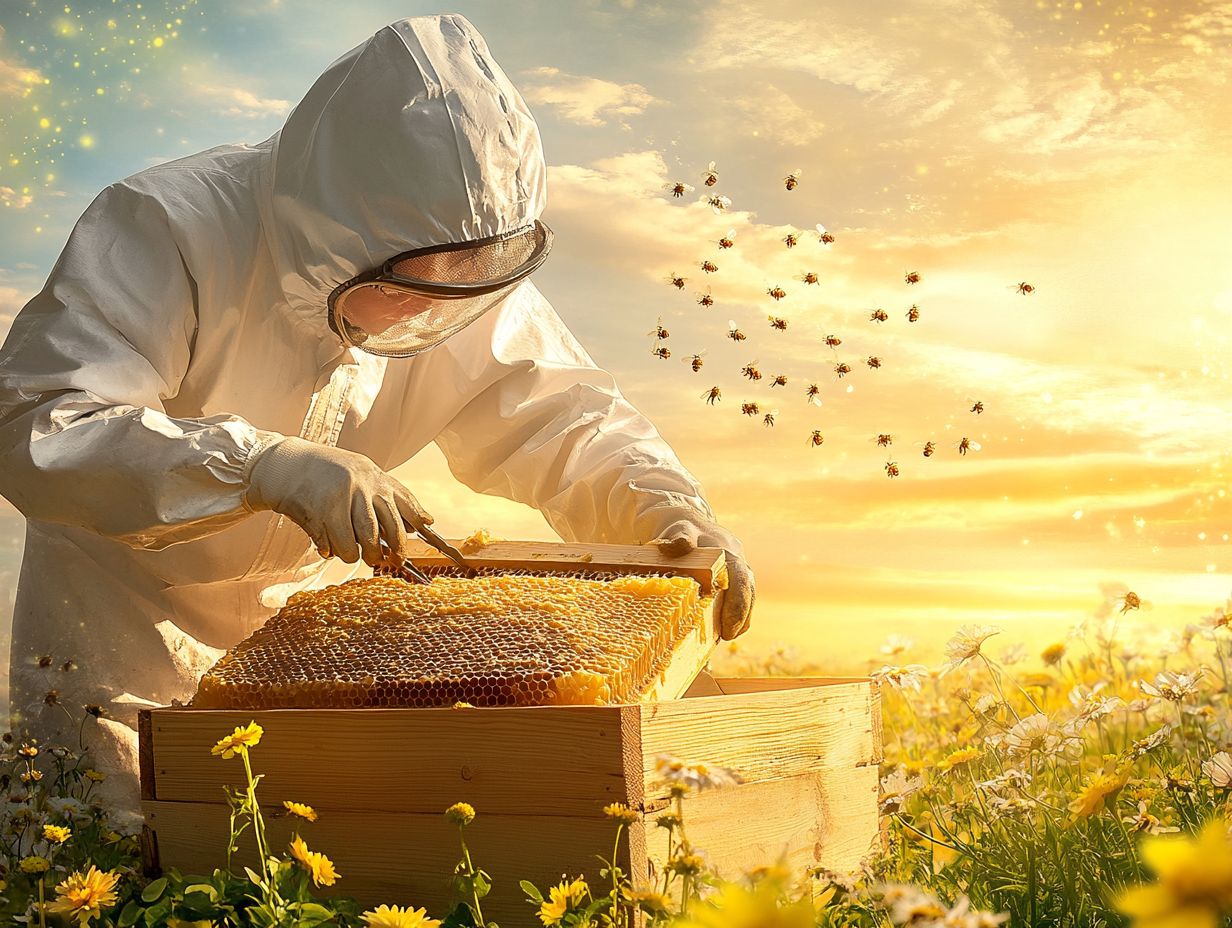
The best hive management practices for beginners include regular inspections, proper feeding and nutrition, managing pests and diseases, providing adequate ventilation, and monitoring the hive’s population and honey production levels.
How often should I inspect my hive as a beginner?
As a beginner, it is recommended to inspect your hive every 7-10 days during the active season. This will allow you to catch any potential issues, such as Varroa mites or Colony Collapse Disorder, early on. Ensure your hive is healthy and thriving.
What should I look for during hive inspections in Missouri?
During hive inspections, check for signs of a healthy queen, the presence of eggs and brood, good honey stores, and signs of pest or disease infestations, such as Nosema ceranae. Note any changes in behavior or activity levels of the bees, as these could indicate issues with Queen health.
How can I manage pests and diseases in my hive?
To manage pests and diseases in your hive, it s important to regularly monitor for signs of infestations. Take preventative measures such as using screened bottom boards and proper hive ventilation. The Honey Bee Health Coalition provides resources to help you manage these issues. If a problem arises, consult with a local beekeeping association or expert, such as those affiliated with the University of Missouri, for the best course of action.
What is the best way to feed my hive as a beginner in California?
For beginners, the best way to feed your hive is by using a top feeder or entrance feeder. These methods allow for easy access for the bees and minimize the risk of robbing from other hives. It’s important to use proper nutrition supplements to ensure your bees are getting all the necessary nutrients. Publications such as American Bee Journal and Bee Culture offer valuable advice on feeding practices.
Get ready to enjoy the sweet rewards of your hard work!
How can I ensure my hive is prepared for winter as a beginner in regions like California and Missouri?
To prepare your hive for winter, make sure it has enough honey and pollen for the bees to survive the colder months.
Insulating your hive helps keep it warm. You can also provide a windbreak to shield it from harsh winds.
Watch your hive’s population closely. Strong bees are crucial for surviving winter.
In California and Missouri, beekeeping practices vary due to different climate conditions.
During almond pollination season, bees need extra care to ensure they are strong enough for winter.

